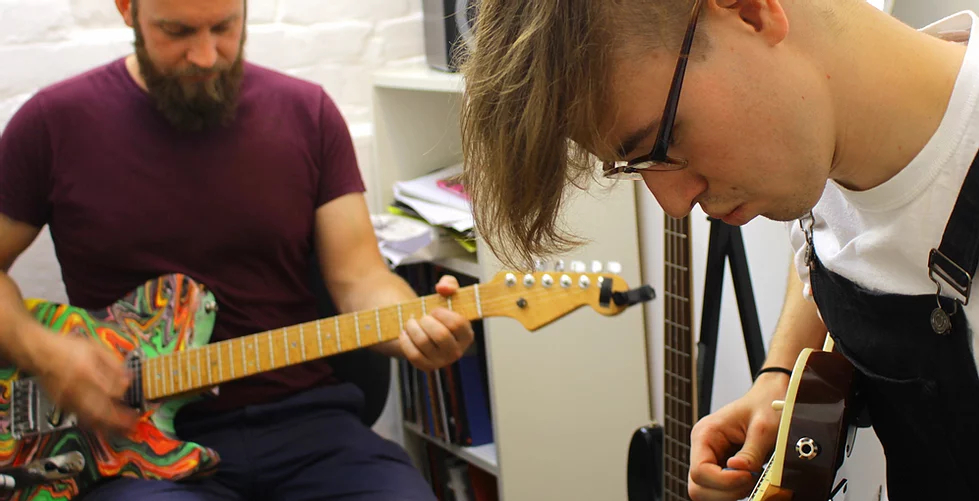Strumming on guitar; it’s a simple up-and-down stroke you make across the strings of your guitar, usually with a flat pick. This guitar technique is easy to do initially but difficult to do well. But, not to worry! Our Guitarlab team are here with the 10 top tips you need to find your strumming groove.
Before we begin, what exactly is strumming? It can be reduced to two basic elements: chords and rhythm. Whilst other elements come into play, chords and rhythm are what make a strum a strum. You may consider the soloist to be the star of the show, but the strummer is the foundation behind the music and is integral to the overall sound of any song. Strummers tend to work with drummers, carrying the rhythm and ambience through a piece. This technique is an indispensable part of a guitarist’s arsenal – if you listen to any rock, pop, country and folk, strumming will tend to be favoured of single-string playing.
#1 Trial a range of picks
To begin with, you’ll want to use a flat pick as this create the best strum sound. Of course, you may have heard of some bare-hand strummers such as Johnny Cash but this is far more difficult, particularly for those just starting out. As the name may suggest, a flat pick is flat – there is no grip on your thumb or fingers, meaning it is more giving when learning strumming on guitar. Pick up a few picks of varying thickness to discover which feels most comfortable for you and provides you with the best sound.
TIP: Once you settle on a particular thickness of pick, keep a few extra handy because you’re sure to lose at least one!
#2 Watch other strummers
Don’t underestimate the power of visuals! Watching a good strummer can be a highly effective learning method as you pick up on their styles and trial these yourself. You may discover a new technique you would have otherwise not considered. If you need a little inspiration on who to watch, have a look at a few of our favourites:
- Keith Richards
- John Lennon
- Nile Rodgers
- Malcolm Young
- Joe Strummer
- Black Francis
#3 Choose a song and play it all the way through, even if you are struggling!
Ask your teacher for the chords of a song – it doesn’t have to be anything overly complicated, just a song with a few simple chords will work perfectly! Then, experiment with playing the song all the way through utilising the strumming technique, no matter how many mistakes you make. Practice is crucial, and mistakes are a natural part of the development process.

#4 Experiment
Once you’ve played a song all the way through, it’s time to practice a little mindfulness and experiment to find the sweet spot. On an acoustic guitar, you’ll naturally strike the strings over the soundhole, but this will not provide you with the fullest sound – you’ll actually need to move back and forth between the soundhole and the bridge.
In addition, as a beginner, you may neglect some of the strings whilst strumming on guitar. Slow down your pace and practice both up and down strokes focusing on hitting each string. Whilst playing a song in full will build your confidence, playing mindfully will provide you with a solid foundation to build upon.
#5 Hold your pick correctly
It’s important you hold the pick in a way that allows it to bend a little when you strum, yet so that it doesn’t fly out of your grip. The majority of guitarist hold the pick between their thumb and the side of their forefinger.
Remember, you want to keep a relaxed grip on the pick with the pointed end sticking out away from your hand. You typically want to leave about a half-inch of your pick sticking out from beneath your thumb. However, for strumming, you might want to leave a slightly larger section of your pick exposed.
#6 Let your instrument breathe
There’s a lot to think about when learning to strum on the guitar, one common mistake that develops from this high level of concentration is holding your instrument too tightly. The sound needs to move through it and if you clutch the guitar too tightly, it won’t be able to. In addition, you’ll want to position your strumming arm and hand so that they don’t deaden the strings.
#7 What to do with your free arm
Strumming depends heavily on your free arm – far more than when single-string flat-picking or fingerpicking. But, what should your free arm actually be doing? You’ll need to be able to strum rapidly and accurately, keeping consistent time with either yourself or band members so you’ll want to be comfortable with your movements.
There’s a lot of controversy about whether to strum from the elbow or wrist. Typically, you’ll discover your own style after practising consistently and generally, this tends to be a balance of both.
#8 Learn basic rhythms and practice, practice, practice!
Put simply, strumming involves strumming up, strumming down, and strumming both up and down along to a beat. There are some basic rhythms you can follow to begin building up your confidence and develop your ability as a musician – being able to keep to a rhythm is a highly valuable skill. However, try to not get too caught up with sticking to precise patterns as the method may become too forced. Strumming on guitar is a freeform technique and, therefore, doesn’t need to be pitch-perfect. Instead, try to find your own groove and go with it!
What’s the most common strumming pattern?
There are four beats here – you’ll play a downstroke on the first, followed by another downstroke on the second. On the upbeat, you’ll play an upstroke, along with another on the third upbeat. Finally, the fourth beat is downwards, and the fourth upbeat is upwards.
One of the best things about this strumming pattern is that it can serve as a substitute for some more complex patterns. As you practice, you will notice that you can play this or a variation of it in almost every song. One of the popular songs that use this pattern is Brown Eyed Girl by Van Morrison.
#9 Understand how to dampen strings
Dampening strings is a relatively simple technique and is a useful tool for even beginners. It means that for a second you don’t press down on your chord as hard as you usually would and, as a result, you create a sound that holds off the guitar’s resonance while creating a crisper beat.
To achieve this dampening, hold down the strings as you normally would and then repeatedly lift your fingers just enough that the strings don’t sound when struck – try doing so along with the beat.
#10 Have fun with it!
Whilst we could go on with additional tips, the biggest takeaway for your strumming practice is to have fun with it and play with enthusiasm. Both single-string flat-picking and fingerpicking require a level of enthusiasm too, but with the immediacy and simplicity of strumming, enthusiasm really brings this method to life.
Watch your favourite guitarist online or listen to your favourite song before picking up your own instrument to get your motor running. Then, play a song all the way through from start to finish with that same energy – you’ll feel the difference in your playing!
Strumming on guitar: The bottom line
Strumming is a key component of guitar playing and though it appears deceptively simple, it requires a lot of consistent practice to find your own groove and successfully nail the technique. It’s vital you bring energy and enthusiasm to your playing to ensure you can continue to develop as a guitarist – without this motivation and joy of learning, you may soon find yourself struggling. Alongside this, when practising your strumming, you want to bring a certain degree of mindfulness to your playing as this will allow you to make significant progress – you won’t just be striking strings and hoping for the best!
Remember, strumming is all about going with the flow – be sure to check out a few of your favourite guitarists to study their style and try incorporating a blend of these into your own playing to help you find your own comfortable style.
Are you ready to take on the challenge and find your strumming groove? Whether your new to the instrument or want to advance your practice, our passionate Guitarlab teachers can help you develop as a guitarist. With over 50 years of experience between us, we have the expertise and proven methods that will see you strumming along to your favourite songs in no time! Contact the team at Guitarlab at 01483 239935 or 07429 074072 and we’ll be more than happy to discuss our teaching services with you.






